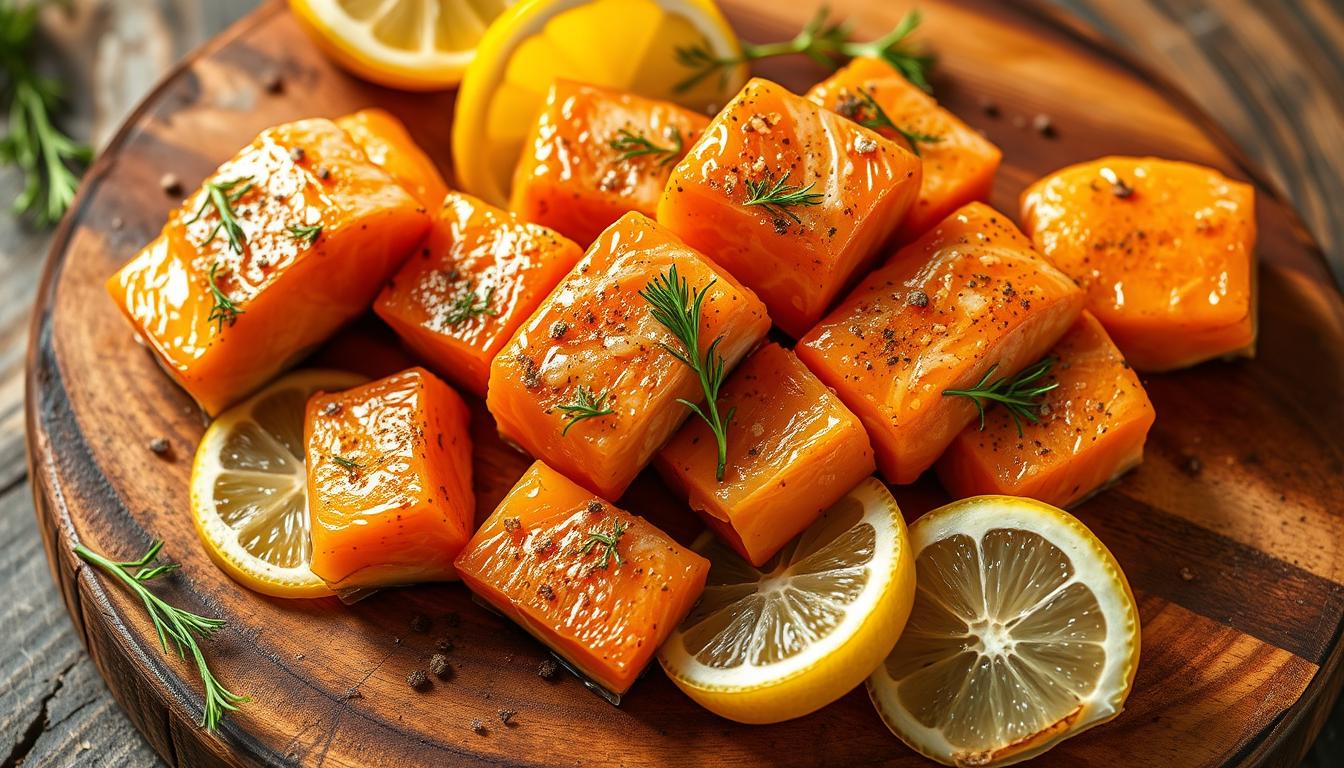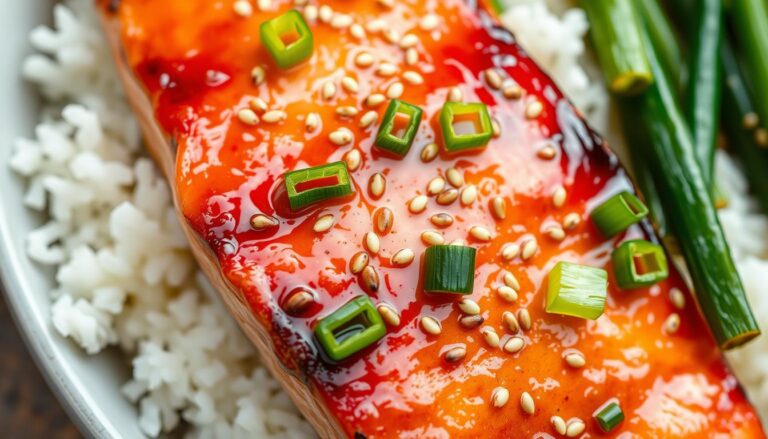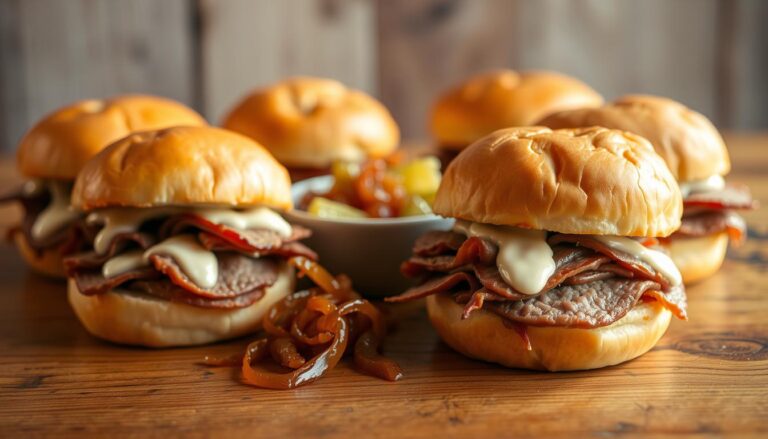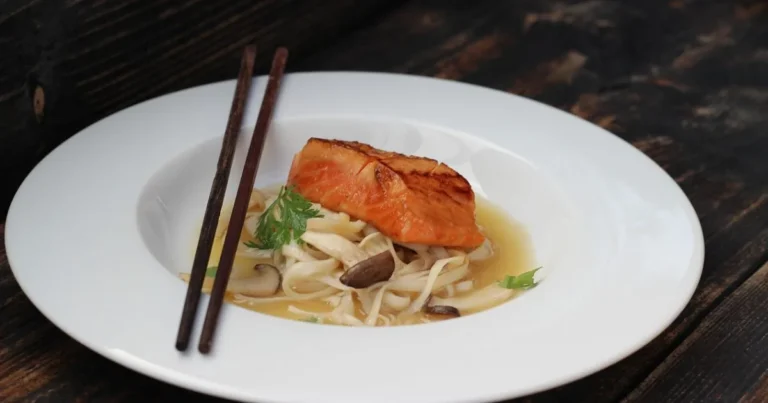Salmon Bites in Oven | Easy & Tasty Appetizer Recipe
Salmon bites in oven bring back that moment when a simple plate gathered everyone at the table. You can recreate it with a quick, bold appetizer that’s ready in about 15 minutes.
This recipe uses a blackened-style spice mix—paprika, garlic powder, thyme, oregano, cayenne, brown sugar, and salt—for crisp edges and juicy centers. You’ll cube thicker fillets so pieces cook evenly and never dry out.
Want sweet-savory instead? A quick teriyaki soak for 15–30 minutes adds gloss and depth. Roast hot at 400°F for 7–10 minutes and pull at about 125°F for tender results or up to 145°F if you like firmer texture.
One bowl, one sheet pan keeps cleanup fast. Finish with a basil ranch made from mayo, Greek yogurt, fresh basil, and lime for a bright dip. Swap to the air fryer when you want crisp edges even faster.
These bites work as appetizers, party snacks, or salad toppers—simple ingredients, big flavor, and minutes to wow your guests.
Quick Intro: What Makes These Baked Salmon Bites a Go-To Appetizer
A hot sheet pan and a short roast bring big flavor fast. You preheat oven to 400–450°F so the exterior caramelizes while the interior stays moist. For a blackened crust, use 450°F and roast 8–10 minutes; for a milder bake, set 400°F and roast 10–12 minutes.
Toss cubed fillets with spices and a bit of oil in one bowl, then spread them with space on a lined sheet pan. Group larger pieces near the back of the oven so you can pull smaller pieces a few minutes earlier.
Hands-on time is minimal, so the total time to serve is realistic on busy weeknights. This simple recipe scales well: use multiple pans and rotate, or bake batches for a larger meal.
- Preheat oven to ensure quick caramelization.
- Thin coat of oil on the pan prevents sticking.
- Cook generally under 15 minutes—fast, easy, crowd-ready.
| Variation | Temp (°F) | Time (minutes) | Finish |
|---|---|---|---|
| Blackened | 450 | 8–10 | Bold crust, tender center |
| Milder bake | 400 | 10–12 | Even cook, gentle color |
| Scaled crowd batch | 400–450 | 8–12 | Rotate pans for consistency |
Why You’ll Love This Recipe
You’ll love how little work it takes to get big flavor on the table. This dish is built for busy nights: short prep, few ingredients, and a fast finish. Use thicker fillets to cube evenly and avoid guesswork.
It’s easy
One bowl, one sheet pan. Toss the pieces with a splash of olive oil and your spice mix, then spread them so they roast evenly. Cleanup stays tiny, which makes repeat weeknight cooking painless.
It’s fast
With the oven hot, small cubes cook in about 8–12 minutes. That means you can time sides or a salad and have a full meal ready in minutes.
It’s budget-friendly
Frozen fillets work well when fully defrosted; buying frozen wild-caught in bulk often cuts cost. Pantry spices like paprika, garlic powder, onion powder, cayenne, thyme, oregano, brown sugar, and salt pull double duty across many dishes.
- Most spices are staples you’ll reuse.
- Serve these as an appetizer or with plain rice and quick veg for a simple plate.
- The method is consistent: toss, arrange, bake, and serve.
Ingredients & Smart Substitutions
Choosing the right fillet and pantry staples sets this recipe up for success. Use wild-caught or your preferred salmon; fully defrost frozen fillets before cutting. Thicker center-cut pieces cube more evenly and cook consistently.
Fish and basic prep
Remove the skin for better seasoning coverage and easier bite-size pieces that crisp at the edges. Pat the flesh dry so the rub adheres.
Seasoning and swaps
Blackened seasoning blends paprika, garlic powder, onion powder, cayenne, thyme, oregano, brown sugar, and salt for a spicy-sweet crust. For milder heat, cut the cayenne and add a pinch of mustard powder and black pepper.
“Keep salts balanced—soy or seasoned rubs can push sodium high, so taste and adjust.”
Optional sauces and finishing touches
For a creamy dip, blitz mayonnaise, Greek yogurt, basil, lime, and a touch of onion or garlic powder into a bright basil ranch. For sweet-savory fans, mix soy, water, brown sugar, vinegar, cornstarch, garlic powder, ginger, and sesame oil; marinate 15–30 minutes (no more than 60).
- Sprinkle sesame seeds after baking for crunch.
- Swap coconut sugar for brown sugar for a less refined option.
- Stock these ingredients once and you can rotate flavors fast.
Prep Like a Pro: Skin Removal, Deboning, and Cubing
A few careful steps at the cutting board make every piece cook the same. Follow these simple moves to remove skin, pull tiny bones, and cube for even heat and texture.
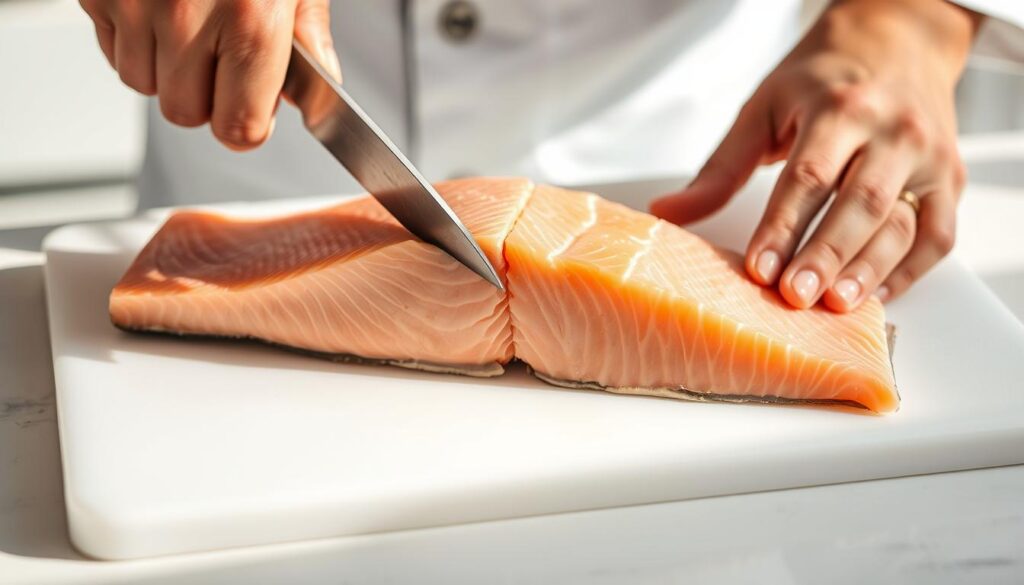
Remove skin and pin bones
Start skin-side up. Make a small cut near the tail so you can grip the edge with a paper towel. Hold the towel tight and peel the skin away.
If the skin resists, slide a flat knife between flesh and skin while keeping the blade nearly parallel to your board.
Run fingertips along the center line to feel for pin bones and remove them with tweezers for safe, neat pieces.
Cube evenly for consistent cooking
Trim off any thin belly sections and set them aside; they cook faster and can be placed separately on the pan.
- Aim for 1–2-inch cubes so every piece finishes at the same time.
- Place salmon on a stable, non-slip board before you cut for tidy results.
- Add cubes to a bowl to toss with oil and seasoning, grouping similar sizes for easy pan layout.
How to Make Salmon Bites in Oven
Begin with a hot oven and a prepared pan to lock in moisture and color. Preheat oven to 400°F for 10–12 minutes or 450°F for 8–10 minutes based on your seasoning and cube size.
Prep the pan first. Line the sheet with parchment paper or lightly oil the sheet so pieces won’t stick and edges can brown.
Season in a bowl
Mix your spice blend in a bowl before you add salmon. Drizzle olive oil over the cubes so the rub clings and every piece has flavor.
Sheet pan setup
Spread pieces with space between them so hot air circulates and edges roast, not steam. Group similar sizes and slide larger cubes toward the back of the pan where heat runs hotter.
Bake minutes and doneness
Bake 7–12 minutes, checking early. Pull when the flesh flakes easily and measures about 125°F for a tender finish. Start checking small belly pieces sooner and remove them as they finish.
If you prefer a quicker crisp, use an air fryer at 400°F for shorter minutes and similar results.
Bake Time, Temperature, and Perfect Doneness
Aim for a target temperature, not a timer, when you want reliably tender results.
Use a quick-read thermometer to guide you: many cooks pull at about 125°F for a flaky, moist finish. The USDA recommends 145°F if you prefer a firmer, fully cooked profile.
At higher heat (around 450°F) expect average 1–2-inch cubes to finish in roughly 8–10 minutes. At 400°F, plan on about 10–12 minutes and start checking early to protect moisture.
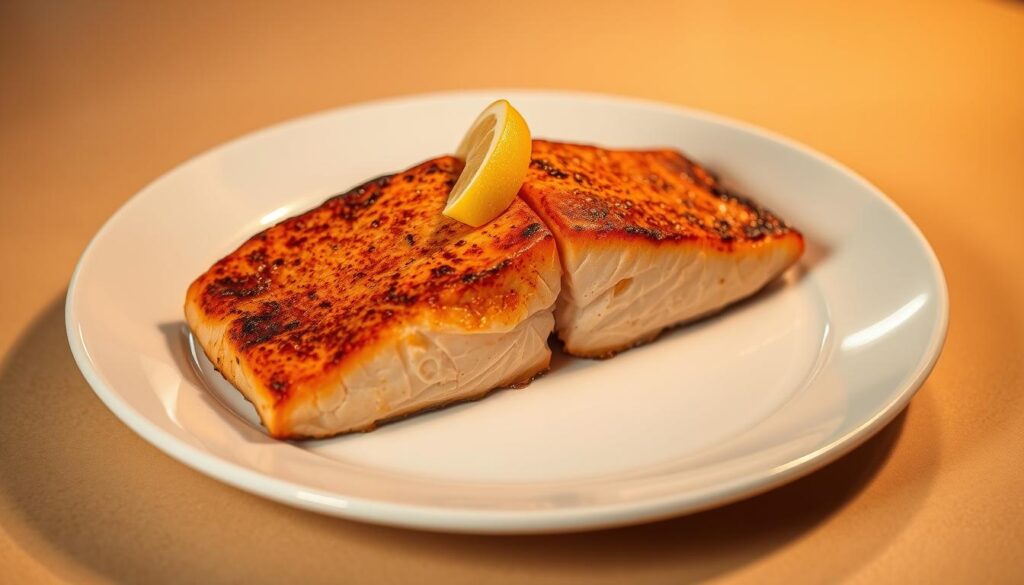
“Residual heat continues cooking after you remove the pan, so pull slightly early for perfect carryover.”
- Use a quick-read thermometer to aim for 125°F (tender) or up to 145°F (firm).
- Smaller, thinner pieces finish first; give larger center-cut cubes an extra minute or two.
- Consistent cube size standardizes time minutes and cuts down guesswork.
- If you sauce after baking, pull a little shy of the final temp so the finish stays tender.
| Heat | Typical Time (minutes) | Target Temp | Result |
|---|---|---|---|
| 450°F | 8–10 | 125°F–145°F | Quick caramelization; watch for carryover |
| 400°F | 10–12 | 125°F–145°F | Gentler color and even cooking |
| Variable (thick cubes) | +1–2 minutes | 125°F–145°F | Center-cut pieces need extra time for even doneness |
Flavor Variations: Blackened, Teriyaki, and Mild Kids’ Version
Pick a flavor lane—spicy blackened, glossy teriyaki, or a mild version that kids will like. Each uses the same bake method so you can swap flavors without extra fuss.
Blackened crust
For a bold crust, combine paprika, garlic powder, onion powder, thyme, oregano, a pinch of cayenne, brown sugar, salt, and black pepper. Roast hot at 450°F for 8–10 minutes so the spices toast and edges caramelize without burning.
Teriyaki glaze
Whisk soy, water, brown sugar or honey, a splash of vinegar, cornstarch, garlic powder, and ground ginger. Marinate 15–30 minutes, bake at 400°F about 7–10 minutes, then toss with sesame seeds for crunch and gloss.
Mild, kid-friendly
Reduce the cayenne and add a pinch of mustard powder for gentle warmth. Keep salt low if you use a soy-based sauce so the finish stays balanced.
- You can do half blackened and half teriyaki for variety.
- For extra gloss, toss finished pieces with a spoonful of warm sauce before serving.
- Finish with chopped herbs or green onions for fresh contrast.
“Adjust salt carefully, especially with soy-based sauces, to keep flavors balanced.”
Tasty Ways to Serve Baked Salmon Bites
Make bowls by piling steamed grains, crisp veg, and a generous drizzle of sauce.
Rice and grain bowls: Serve over steamed rice, couscous, or creamy noodles. Add crunchy cucumbers, shredded carrots, and a spoon of basil ranch or teriyaki for contrast.
Salads: Toss warm pieces onto a Caesar or a bed of mixed greens dressed with lemon-mustard. Try cherry tomatoes and burrata for a brighter, more elegant salad.
Sides and dips: Pair with roasted asparagus, broccoli, zucchini, or peppers. Offer basil ranch and extra teriyaki so guests can pick a favorite sauce.
“Use a quick air fryer reheat to refresh crisp edges before plating; it brings texture back fast.”
- Build bowls with steamed rice or couscous, veggies, and a drizzle of sauce.
- Swap these pieces for chicken as a high-protein topper on salads.
- For kids, serve plain with rice and a mild dip for familiar flavors.
| Serving Style | Main Components | Best Finish |
|---|---|---|
| Bowl | Rice, veggies, basil ranch | Drizzle sauce; sprinkle sesame |
| Salad | Greens, lemon-mustard, cherry tomatoes | Warm pieces tossed on top |
| Plated sides | Roasted asparagus, broccoli, peppers | Pair with extra teriyaki or ranch |
Storage, Reheating, and Air Fryer Option
Store leftovers smartly so they stay juicy and ready for quick meals all week. Cool pieces briefly on the sheet, then move them to airtight containers. Chill in the fridge for 3–4 days; some batches hold well to day five when properly cold.
Reheating well keeps texture and flavor. For crisp edges, use the air fryer at 400°F for 2–3 minutes. If you prefer a skillet, warm a nonstick pan with a splash of oil over medium heat until pieces are heated through.
Microwave only in short bursts and cover lightly to prevent drying. If you stack portions, place parchment paper between layers to stop sticking.
- Toss reheated pieces with a spoon of basil ranch or teriyaki sauce to revive moisture.
- For a large tray, warm briefly in the oven but watch time to avoid overcooking.
- Prep tip: bake salmon ahead, chill, and refresh in the air fryer just before serving.
| Method | Temp | Minutes | Result |
|---|---|---|---|
| Air fryer | 400°F | 2–3 | Quick crisp, restored edges |
| Skillet | Medium | 3–4 | Gentle reheating with oil |
| Microwave | High (short) | 30–60 sec bursts | Fast, risk of dryness |
“Always reheat just until hot and flaky; small pieces can overcook fast.”
Conclusion
A tidy finish—resting, a light sauce, and a sprinkle—turns prep into a crowd-pleaser.
With a hot pan, even cubes, and a reliable spice blend or quick marinade, these baked salmon bites finish fast and flake beautifully. Aim for about 125°F for tender flesh or 145°F if you like a firmer finish.
Serve warm over rice or mixed greens with basil ranch or teriyaki. A light coat of olive oil helps seasonings cling and encourages browning, and parchment paper on the sheet makes release effortless.
Store leftovers 3–4 days and revive them briefly in the air fryer or a hot pan with a splash of oil. Finish with sesame seeds, a pinch of garlic powder, and black pepper for extra flavor.

